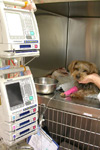The Patient
Unit 8: Post-Operative Considerations
Care of the surgical patient does not end at the termination of the procedure. The successful outcome of the procedure may in fact rely entirely on the quality of the postoperative care provided.
Adequate postoperative care requires continued monitoring of the patient for potential problems, pain management, normalisation of homeostasis and management or protection of the surgical wound.
In general postoperatively patients should be placed into a warm quite comfortable environment to recover from the anaesthetic. Any intravenous fluid therapy or monitoring procedures commenced in surgery should be maintained until the animal has recovered. Hypothermia should be detected by repeated monitoring of body temperature, and corrected with heating pads, heated cages or warm water bottles until normal and the animal is able to maintain its own thermoregulation.
The animal should be turned regularly or placed in sternal recumbency to prevent atelectasis of the lung lobes on the dependent side.
Management of Pain
Patients suffering painful wounds or undergoing surgical procedures should receive analgesic medication. Prolonged pain may result in immunocompromisation, an increased infection rate and a hyper-metabolic state.
Assessing pain in an animal can sometimes be difficult without a comprehensive knowledge of the animal’s normal behaviour. Significant interspecies differences also exist. Cats are generally less expressive of pain.
Pain can manifest itself as general changes in behaviour such as loss of appetite, changes in sleeping patterns, vocalisation, restlessness, lack of playing or grooming, changes in temperament and guarding of the painful area.
Clinical signs that may accompany pain include increases in heart rate, pallor of mucous membranes, increased blood pressure and occasionally cardiac arrhythmias.
The analgesics used in small animal practice are most commonly opioid analgesics or non-steroidal anti-inflammatory agents.
Opioid analgesics may lead to increased vagal tone and bradycardia, panting, and at high doses, respiratory depression.
The non-steroidal anti-inflammatory drugs inhibit the production of prostaglandin and thromboxane through reductions in cyclooxygenase activity. The most common side effects are gastrointestinal tract irritation and ulceration. In patients with low blood pressure or poor renal function, renal failure may be precipitated.
A carprofen-associated hepatic toxicosis has also been reported and is believed to be idiosyncratic and host dependent.
Analgesia is best provided pre-emptively, usually at the time of anaesthetic induction, to block the pain pathways from the periphery to the brain and prevent ‘dorsal-horn wind-up’ during the procedure. Analgesia given post-operatively often requires higher doses of the drug to be effective.
Analgesic Doses
Drug |
Dose(mg/kg) |
Route |
Dose Interval (hours) |
Morphine |
0.05-0.4 (dog) |
IV |
1- 4 |
Fentanyl |
0.003-0.01 (dog) |
IV |
0.5-1 |
Butorphanol |
0.2-0.8 (dog) |
IM, SC |
1-3 |
|
|
IM, IV, SC |
4-8 |
|
4.0 |
IV, SC, PO |
24 |
|
|
IV, IM, SC, PO |
24 |
|
10-20 (dog) |
PO |
12 |
Local Analgesia
Local analgesia is occasionally used alone, but is more commonly used as an adjunct to general anaesthesia for the management of pain.
The use and methodology of specific local anaesthetic techniques and regional nerve blocks (e.g. intercostal blocks) will be discussed in more detail in the relevant sections of other the anaesthetic course.
Epidural block
Epidural blocks can be a very useful adjunct procedure in providing analgesia during major surgical procedures, particularly of the hind limbs and pelvis.
A number of agents have been placed in the epidural space including local anaesthetics (lignocaine, bupivacaine) and opioids (morphine, and occasionally butorphanol and fentanyl).
Maintenance of Nutritional Requirements
An essential, yet infrequently considered component of postoperative care is the maintenance of the nutritional requirements of the patient who may be debilitated or anorexic.
Inadequate nutritional support may result in malnutrition which can be defined as progressive weight loss, and may result from:
- Inadequate intake or loss of nutrients (eg. anorexia, vomiting, diarrhoea, burn wounds)
- Increased protein and caloric demand (eg. trauma, surgery fever).
The consequences of malnutrition are many and varied and include:
- Impaired immunocompetence
- Poor wound healing
- Hypoproteinaemia
- Organ and muscle atrophy.
Increased nutrition may be provided in a number of ways including increased provision of food (hyperalimentation), enteral alimentation (tube feeding) into a functional gastrointestinal tract (eg. oesophagostomy, gastrostomy and enterostomy tubes), and parenteral alimentation which provides nutrients via an intravenous route.
The nutritional requirements also depend on the condition and activity of the animal. Severely traumatised animals may have energy requirements 1.5 – 2.0X basal requirements.
Details of calculating dietary requirements and the delivery of the diet, including placement of enterostomy tubes will be provided elsewhere.


